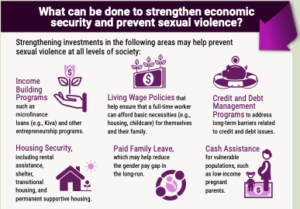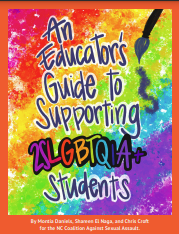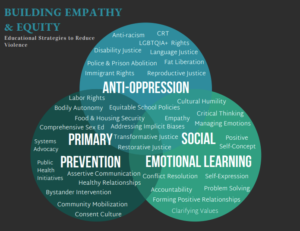Messaging Prevention – New Resources from the Field
As the evidence base for what works to prevent sexual and intimate partner violence grows, practitioners are met with opportunities to explain the how and why of prevention. Sexual and intimate partner violence are complex public health problems whose root causes and solutions mirror that complexity. CDC’s technical packages have helped categorize prevention approaches into corresponding prevention strategies, and have provided potential outcomes and the best available evidence for each approach.
Still, messaging how a prevention approach like strengthening economic supports for women and families can prevent sexual violence, can be tricky. The ability to clearly and concisely message prevention strategies can increase buy-in among stakeholders, partners, and community members. Additionally, the pattern of anti-Critical Race Theory, anti-LGBTQ, and anti-transgender legislation passed across the country in recent years directly impacts how practitioners message and carry out sexual and intimate partner violence prevention. Violence is rooted in oppression and in climates where there is deep resistance to uprooting oppressive systems, prevention practitioners are having to find ways to overcome barriers in advancing their work.
New resources from North Carolina, Ohio + Florida, and California can help. Read on to learn about new violence prevention messaging tools.
Showing the Connection Between Economic Security and Sexual Violence Prevention

A two-page infographic released by the California Department of Public Health’s (CDPH) Rape Prevention and Education (RPE) Program highlights how economic insecurity can increase the likelihood of sexual assault while economic security can prevent violence. Preventing Sexual Violence Against Women and Girls: What’s Economics Got to Do with It? looks at individual, community, and societal level aspects of economic supports and provides examples of programs and policies that can strengthen economic supports.
Messaging Inclusive Curricula + Gender-Affirming Care and Sexual Violence Prevention

The North Carolina Coalition Against Sexual Assault (NCCASA) has created a set of messages that link the importance of inclusive curricula and gender-affirming care for young people to sexual violence prevention. These sample messages are short enough to use on social media, but are also helpful in any type of communication about prevention. Each message also includes additional context and information to further connect the dots and increase knowledge around risk and protective factors.
NCCASA also recently released An Educator’s Guide to Supporting 2SLGBTQIA+ Students. This guide provides opportunities for skill and knowledge building for educators to “help foster safer and more supportive learning environments, greater peer understanding, and a deeper connection to school” for 2SLGBZTQIA+ students and all students. Both the messaging resource and the educator’s guide from NCCSSA are important offerings in advancing primary prevention.

Overcoming Barriers to School-Based Prevention
The Florida Council Against Sexual Violence (FCASV) and Ohio Alliance to End Sexual Violence (OAESV), with input from Wisconsin Coalition Against Sexual Assault, have created the School Based Prevention Roadmap for prevention practitioners in climates where bans on Critical Race Theory (CRT) and other curricula have created barriers for practitioners doing school-based prevention. OAESV has previously blogged about these experiences.
Anti-oppressive frameworks are critical to successful prevention education and this resource provide ways for prevention practitioners to navigate the push back they may experience while remaining committed to advancing equity. The Roadmap uses visuals to connect CRT, anti-oppression, Social Emotional Learning, and primary prevention while also including the context of the ongoing COVID-19 pandemic. The resource provides messaging to assist with dispelling misconceptions about CRT, including the conflation of CRT with Social Emotional Learning (SEL). A Venn diagram of educational strategies that build empathy and equity to prevent violence provides a visual of the relationship between anti-oppression, SEL, and primary prevention. Additional resources from OAESV include a handout and infographic for addressing and overcoming barriers in prevention.
For more resources on prevention messaging, check out our previous blog New Resources on Prevention Communication and Media Messaging and materials from our web conference Creating Stories for Gender Justice: A Narrative and Culture Change Strategy to Prevent Sexual and Domestic Violence.
